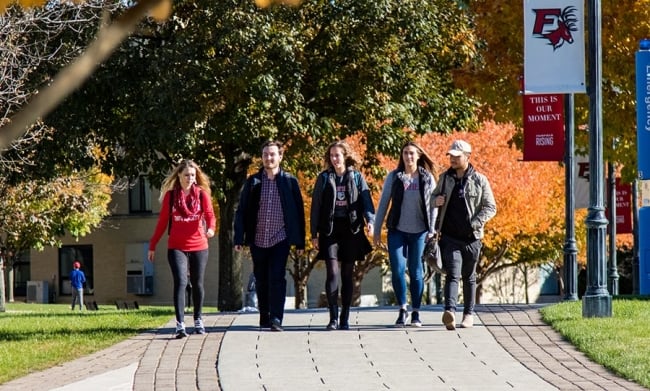You have /5 articles left.
Sign up for a free account or log in.

Fairfield University is launching an affordable two-year college in the neighboring, and poorer, city of Bridgeport. But some residents have reservations.
Fairfield University
Fairfield University leaders proposed the creation of Bellarmine College as a way to give back to its socioeconomically disadvantaged neighbor, Bridgeport, Conn.
The Jesuit university in Fairfield, Conn., developed the plan in partnership with the Bridgeport Roman Catholic Diocese to provide low-income students in Bridgeport with a two-year associate degree at little to no cost. It would also offer advising and mentorship to help those students find employment after graduation or go on to enroll in a bachelor’s degree program, at Fairfield or elsewhere.
Many of the city’s residents are excited about the opportunities Bellarmine presents. But some locals, while appreciative of the mission, have resisted efforts by Fairfield University and the diocese to open the college in Bridgeport.
The city granted Fairfield initial approval to locate the college in a former Catholic school building in the town’s north end back in April. But that decision was reversed and the diocese withdrew the application following heated opposition from some locals who said the plans violated the town’s zoning laws and expressed concern that the college would lead to traffic congestion and decreased property values.
Tentative plans are in the works to house Bellarmine in an alternate location, at another former Catholic school building on the other side of town—down the street from Bridgeport Hospital and a methadone clinic, away from the predominantly residential neighborhoods. But while negotiations seem more hopeful, some residents who live near the new location are voicing the same reservations raised in April.
Jennifer Anderson, Fairfield University’s vice president of marketing and communications, did not respond to questions about the ongoing resident concerns but said the university was pushing ahead. The new college is set to open in fall 2023, with an initial cohort of 100 students, which will grow to 200 the following year.
“Bellarmine is a bold, innovative effort to address the challenges of access and affordability in Jesuit higher education,” she wrote in an email to Inside Higher Ed. “It will also serve as Fairfield University’s community engagement hub for our work serving the community of Bridgeport.”
Disagreements between higher education institutions and local residents over campus expansions and property devaluation are not new; some have even gone to court. But Fairfield’s trouble in Bridgeport illustrates the challenges of venturing into a new community, even when the move is designed to benefit the people living there.
Bridgeport Over Troubled Water
Michelle Lyons, a Bridgeport city councilwoman who represents the neighborhood where the original site was proposed, helped lead the opposition to the plan. She recruited a retired judge, Carmen Lopez, to file an appeal against the city’s initial approval. Lyons, who lives just across the street from the proposed site, said residents of the neighborhood, which includes a senior center and many retirees, didn’t like the idea of bringing 100 students into the small area every day.
“I didn’t think it would be conducive for the people in the neighborhood who’ve been here a long time. The traffic would increase—we’ve got people riding ATVs down the street, people bypassing stop signs,” she said. “It’s just too much for this area to add more.”
Other Bridgeport residents were thrilled to hear about the arrival of a new college. Sylma Vasconcellos has lived in Bridgeport for 30 years, ever since she dropped out of college in Brazil to immigrate to the U.S. She has two daughters, one of whom attends the local high school, where Vasconcellos serves on the school governance council. She said she believes local students would benefit from the opportunities that Bellarmine affords.
“Being involved at the high school, I see a lot of students who are failing, or some whose parents want them to work instead of going to college, or others who are afraid of going to college,” she said. “Most of the students in Bridgeport are first-generation students, so they don’t have anyone to look to for advice … I think [Bellarmine] would make a lot of difference for them to succeed.”
Vasconcellos said at the city council meetings she attended, concerns were raised largely by retirees, who would not benefit from the college. So she started a Change.org campaign to try and drum up support among Bridgeport parents.
“It’s not a large percent of the community who oppose this,” she said. “They’re just more outspoken.”
Lyons said she was fairly representing her neighbors and constituents and stressed that her main concerns about putting Bellarmine in Bridgeport are purely practical.
“The program itself is a good program,” she said. “It all just comes down to logistics.”
Lyons also wondered why Fairfield didn’t make space on its own campus for Bellarmine College.
“This should have really actually taken place on their campus so the youngsters could experience campus life,” she said.
Anderson said the university and the diocese wanted to locate the college in Bridgeport to ensure it would be accessible to residents, and that similar ventures by other colleges proved successful when the institutions were housed in the communities they were meant to serve. She pointed to two initiatives by fellow Catholic institutions—Arrupe College of Loyola in Chicago and the University of St. Thomas’s Dougherty Family College in St. Paul—as Fairfield’s models for Bellarmine.
“Experience and studies have shown that placing a program like Bellarmine within the city where students live is the most effective model for success,” she wrote.
Some residents agree. When the initial plan to locate the college in the north end was proposed, leaders from Bridgeport’s local NAACP chapter met with Fairfield University’s president and provost about the college. The Reverend D. Stanley Lord, the chapter’s president, said their only objection was that it was too far from the populations that would benefit most from the college.
“Our whole thing was accessibility,” he said. “They say that if you build it, they will come, but in that case they couldn’t come if they couldn’t get there.”
If the east end location is approved, Lord said the university would have the Bridgeport NAACP’s full support.
“There is a great need for a positive environment of a school right there in their own backyard,” he said. “Bellarmine would allow students who didn’t feel they could reach that secondary level of education to now do their higher education all in their town, and not at a high cost.”
Narrowing the Opportunity Gap
Fairfield County, where Bridgeport and Fairfield are both located, has the highest rate of income inequality of any county in the U.S., according to a 2019 study by the Federal Reserve Bank of New York. And Bridgeport, the most populous city in both the county and state, with almost 150,000 residents, is also one of Connecticut’s poorest and most diverse.
According to data from the 2020 Census, almost a quarter of Bridgeport’s population lives below the poverty line. And according to a 2019 community well-being index by the Fairfield County Community Foundation, the majority of children in Bridgeport belong to low-income families—64 percent in 2017, up from 51 percent in 2000. The index also showed that 79 percent of the city’s residents are people of color.
Though the area is home to three higher education institutions—the University of Bridgeport, Sacred Heart University and Housatonic Community College—fewer than 20 percent of Bridgeport residents over 25 have a bachelor’s degree, according to 2020 Census data.
Meanwhile, just over the Ash Creek tidal basin in Fairfield, 5 percent of residents are impoverished and 67 percent of people over 25 have a bachelor’s degree. Fairfield is also 88 percent white.
Davarian Baldwin, the author of In the Shadow of the Ivory Tower, said Connecticut’s socioeconomic inequality is due mainly to the extraction of local wealth away from urban centers and into its suburbs—and, by extension, the private universities that primarily serve them. He calls them “wealth islands,” vortices into which resources from urban centers flow and stick, and says their creation has historically been motivated by racism and exploitation.
“There’s a long history of racial divestment in the building out of the suburbs, and in the creation and funding of universities to serve these communities,” Baldwin said.
Baldwin, who teaches an hour upstate from Fairfield at Trinity College, said the root causes of the area’s socioeconomic disparity make a low-cost two-year degree program effectively futile unless paired with other solutions—including affordable, quality housing and better-paying jobs—to ensure long-term success.
“We live in a knowledge economy where colleges and universities all over the country, both big and small, are at the center of the economy—in terms of research and development, in terms of real estate, retail, health care, even police. When we take an accounting of all these various layers of disparity, universities aren’t doing anything to offset it with their degree giveaways and tutoring programs,” he said. “Education is an important vehicle for upward mobility, but if you’re really going to look out for the needs of Bridgeport residents, it has to be done substantially.”
Anderson said Bellarmine is Fairfield’s way of working to address the disparity.
“Addressing opportunity gaps that exist in our communities is more important now than it ever has been,” Anderson wrote. “Bellarmine College provides a new pathway for access for a new set of students who have the potential to succeed, but have not had the opportunity presented to them during their high-school years.”
Vasconcellos said she loves her hometown, but it is “struggling” with poverty, violence and joblessness. She believes Bellarmine would make a difference in the social and economic prospects of its young people and, subsequently, improve the general quality of life.
“It has the potential to change Bridgeport itself,” she said. “As more people go to school, get jobs, the whole environment, everything is going to get better.”





